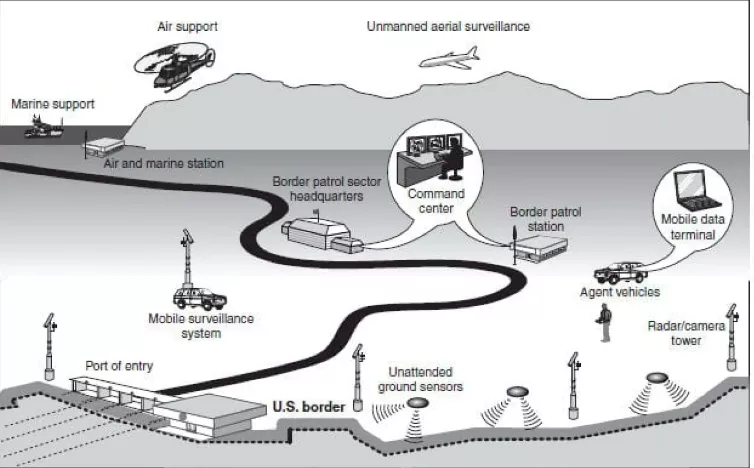Smart Walls For Borders | 05 Feb 2021
Why in News
Recently, an alternative Smart Wall has been proposed to replace the physical and armed patrolling with advanced surveillance technology at the USA-Mexico border.
- Earlier in 2019, the USA declared a national emergency to fund construction of a border wall along the USA-Mexico Border citing "invasion" of drugs and criminals from Mexico.
Key Points
- About Smart Wall:
- There is no one single definition for this recently-conceived solution, however It is a collection of discrete technologies that work together to prevent illegal entry, smuggling, and all the various threats posed by a porous border.
- It uses drones, scanners, and sensors to create a technological barrier too high to climb over, too wide to go around, and too deep to burrow under.
- Using Internet-of-Things (IoT) technologies like in-ground sensors, security cameras and software solutions, a smart wall could empower border officials with enhanced situational awareness to prevent illicit activity.
- Benefits of Smart Wall:
- Reduces Cost:
- A smart wall can accomplish the same goals as a physical wall with a much smaller price.
- Decreases Deployment Time:
- Physical boundaries take years to build but smart border technology is ready to go.
- Low Maintenance Costs:
- Unlike a physical barrier, a smart wall would allow border security officials to continuously adjust tactics to changing conditions.
- Ground sensors and IoT devices are quick and easy to deploy and inexpensive to move and update.
- They require only a fraction of the costs to maintain, and can be implemented gradually and as needed.
- Decreases Environmental Concerns:
- A smart wall raises minimal environmental concerns, allowing wildlife and rainwater to pass freely through the area.
- Most smart devices can tell the difference between people and animals, alerting officers when a human attempts to cross the border illegally while leaving wildlife alone.
- Overcomes the Limitations of Terrain:
- Rough terrain is difficult to patrol, which could leave portions of the wall vulnerable to breaches.
- Digital technology, however, allows for enhanced surveillance across vast terrain.
- Devices like cameras and in-ground sensors allow patrolmen to survey hundreds of miles at once, and take informed action should the need arise.
- Real-time alerts make it easy to respond to activity from immigrants approaching the border or to a lost hiker looking for supplies.
- Reduces Land Requirement:
- To construct a border wall, the government would need to seize property from local landowners.
- However, Small and relatively non-invasive, smart wall technologies would require far fewer land seizures.
- Reduces Cost:
- Need of Smart Wall in India:
- A critical factor that must be considered to enable the usage of such a system along Indian borders is that the terrain in the region is rugged, and, furthermore, not even clearly defined.
- Such a system, even if not feasible for India’s long boundaries, may still be deployed to enhance critical security establishments of the country and complement the already existing physical fencing and walls.
- It is imperative for Indian armed forces to be well equipped and simultaneously have the latest technological advantage over its enemies.
- Experts should explore this idea to effectively counter the problem of border infiltration.
- Smart Fencing in India:
- Two pilot projects covering about 71 Kms on Indo-Pakistan Border (10 Kms) and Indo-Bangladesh Border (61 Kms) of Comprehensive Integrated Border Management System (CIBMS) have been completed.
- CIBMS involves deployment of a range of state-of-the-art surveillance technologies — thermal imagers, infra-red and laser-based intruder alarms, aerostats for aerial surveillance, unattended ground sensors that can help detect intrusion bids, radars, sonar systems to secure riverine borders, fibre-optic sensors and a command and control system that shall receive data from all surveillance devices in real time.
- BOLD-QIT (Border Electronically Dominated QRT Interception Technique) under CIBMS on Indo- Bangladesh border in Dhubri district of Assam is also being used.
- Two pilot projects covering about 71 Kms on Indo-Pakistan Border (10 Kms) and Indo-Bangladesh Border (61 Kms) of Comprehensive Integrated Border Management System (CIBMS) have been completed.

